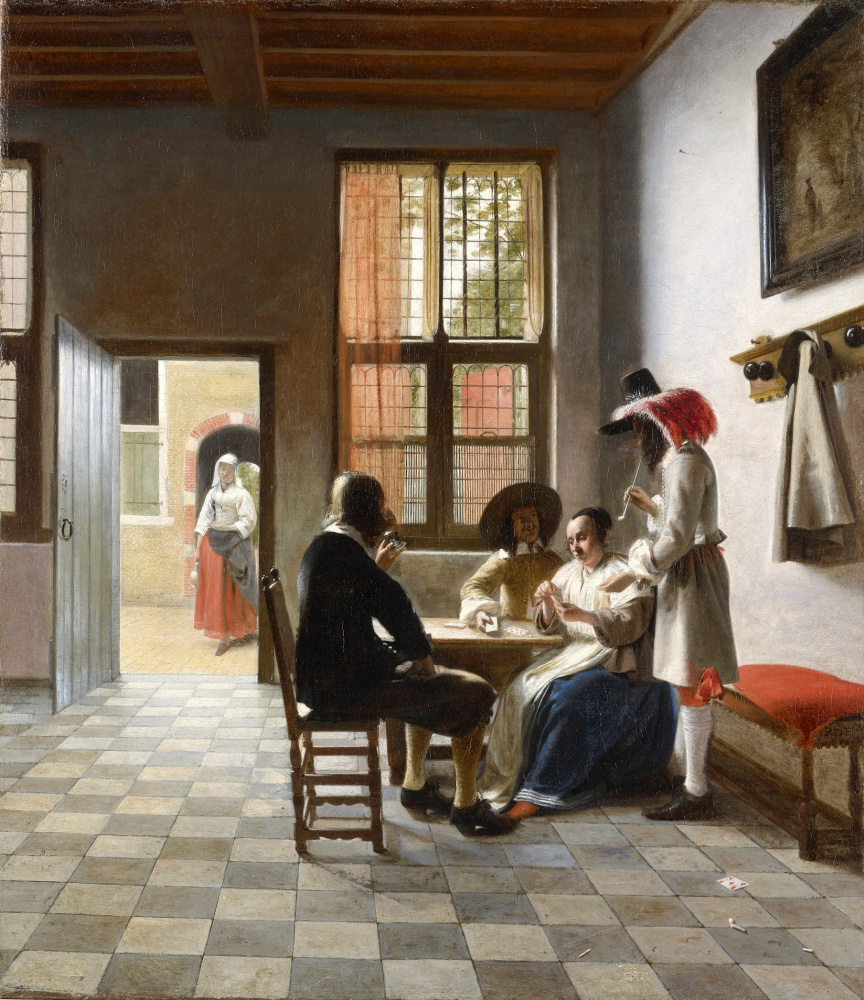log in
Enter site
Login to use Arthive functionality to the maximum
Card players in a sunny room
Pieter de Hooch • Painting, 1658, 77.2×67.4 cm
Description of the artwork «Card players in a sunny room»
The paintings of Peter de Hoch are characterized by an atmosphere of calm, spaciousness and lightness. This effect is achieved thanks to complex perspectives, a combination of colors and virtuoso experiments with light. All these are also essential elements of creativity. Jan Vermeerthat de Hoch knew. "Card players in a sunny room"refers precisely to the most important moment in history when both artists worked in Delft, developing their own special style.
For a long time, it was assumed that the more sophisticated Jan Vermeer influenced Peter de Hoch, whose strokes were often called "inelegant", and human figures were compared to wooden dolls. But dated works like Card Players testify that it was de Hoch who got ahead and led a colleague. Undoubtedly, with the “rediscovery” of Vermeer in the 1860s, de Hoch's reputation was strengthened, but by then his works were in demand and popular by themselves. For example, in 1819, in the inventory of Carlton House, the residence of the future King George IV, two attributed and expensive paintings by de Hoch were listed. it “Yard in Delft in the evening. Spinner"estimated at 400 guineas, as well as "Card Players in a Sunny Room" worth 700 guineas. Both canvases are now part of the Royal Assembly and hang in Buckingham Palace.
In Players in Cards, de Hoch practically turns the interior into a landscape, experimenting with the angle of incidence of the sun's rays (the tiled floor is painted almost like the evening sky) and the play of light on various surfaces. As often happens in landscapes, human figures here are rather secondary. They are relatively small, two men turned their backs on the audience, as if we were accidentally spying on the course of the game. The gambler in black and his chair can generally be read as a complex obstacle necessary to indicate the direction of the light. Thus, the emphasis moves from people to the interior.
The scene is supposedly set in the inn. The heroes smoke, play cards and drink, while the maid brings them a new portion of wine in the jug through the courtyard. The two people on the right are most likely a cheater: the one standing is peering at the cards of the woman, and his partner smiles smugly, throwing out the ace.
Unlike his contemporaries, Peter de Hoch did not fill his compositions with secret codes. The meanings in his works are usually directly related to the depicted objects. Sometimes the artist resorted to the “picture in picture” technique to expand the narrative. But in this case, the landscape on the wall only confirms the records that in the Netherlands even the most modestly furnished rooms were decorated with paintings.
Author: Vlad Maslov
For a long time, it was assumed that the more sophisticated Jan Vermeer influenced Peter de Hoch, whose strokes were often called "inelegant", and human figures were compared to wooden dolls. But dated works like Card Players testify that it was de Hoch who got ahead and led a colleague. Undoubtedly, with the “rediscovery” of Vermeer in the 1860s, de Hoch's reputation was strengthened, but by then his works were in demand and popular by themselves. For example, in 1819, in the inventory of Carlton House, the residence of the future King George IV, two attributed and expensive paintings by de Hoch were listed. it “Yard in Delft in the evening. Spinner"estimated at 400 guineas, as well as "Card Players in a Sunny Room" worth 700 guineas. Both canvases are now part of the Royal Assembly and hang in Buckingham Palace.
In Players in Cards, de Hoch practically turns the interior into a landscape, experimenting with the angle of incidence of the sun's rays (the tiled floor is painted almost like the evening sky) and the play of light on various surfaces. As often happens in landscapes, human figures here are rather secondary. They are relatively small, two men turned their backs on the audience, as if we were accidentally spying on the course of the game. The gambler in black and his chair can generally be read as a complex obstacle necessary to indicate the direction of the light. Thus, the emphasis moves from people to the interior.
The scene is supposedly set in the inn. The heroes smoke, play cards and drink, while the maid brings them a new portion of wine in the jug through the courtyard. The two people on the right are most likely a cheater: the one standing is peering at the cards of the woman, and his partner smiles smugly, throwing out the ace.
Unlike his contemporaries, Peter de Hoch did not fill his compositions with secret codes. The meanings in his works are usually directly related to the depicted objects. Sometimes the artist resorted to the “picture in picture” technique to expand the narrative. But in this case, the landscape on the wall only confirms the records that in the Netherlands even the most modestly furnished rooms were decorated with paintings.
Author: Vlad Maslov


